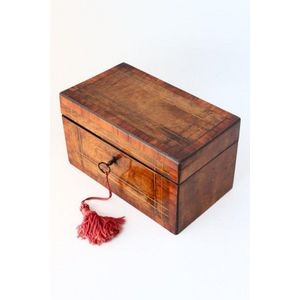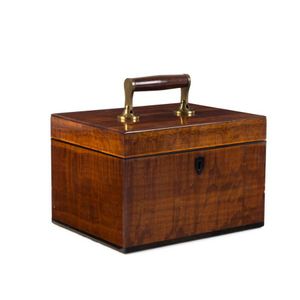Tasmanian Ecclesiastical Box with Inlaid Cross
You must be a subscriber, and be logged in to view price and dealer details.
Subscribe Now to view actual auction price for this item
When you subscribe, you have the option of setting the currency in which to display prices to $Au, $US, $NZ or Stg.
- Casuarina - Casuarina, is also known as beefwood (because of its appearance) she-oak, swamp oak, river oak, forest oak and Botany Bay wood. It is a native Australian hardwood, red brown in colour with dark flecks.
- Huon Pine - Named after the Frenchman who discovered the Huon River in Tasmania, it is an extremely slow growing and long living tree. Huon pine is native to Tasmania, and it can grow to an age of 3,000 years or more. The wood contains oil that retards the growth of fungi, hence its early popularity in ship-building in convict-era Tasmania. The timber is a warm yellow colour, finely grained, and was popular for household furniture in the Victorian era. Interestingly, much Huon pine furniture was made in South Australia. Huon pine is a protected species and only limited quantities are available nowadays, for craftsmen to manufacture small items such as platters, sculptures and other decorative objects.
- Ebony - Ebony is a close grained timber, black in colour. It has a fine texture which can be polished to a high gloss, making it suitable for venereering, inlay and stringing and its use as solid timber is resticted to small decorative items and ornamental decoration, such as chess pieces and musical instrument parts. The term "ebonised" means "faux ebony", timber that has been darkened during the polishing process to resemble ebony.
This item has been included into following indexes:
- boxes, material or decoration
Visually similar items

A Victorian walnut jewellery box, with concealed sprung drawer to the fascia. Fitted interior. 30 x 22 x 170

Victorian lady's travelling box with a mother of pearl inlaid keyhole & panel monogrammed initialled 'MB'. the inside lid has a green crushed velvet spring mechanism. Inside is a pull out compartment containing three rectangular glass scent containers with

Victorian tea caddy, of deep rectangular form, set with cross banded and strung borders, opening to compartments with key, length 20.5 cm

Early brass bound walnut writing slope. Interior fitted with leather covered slope & divided sections. Key available, height 18 cm depth 25 cm, length 45 cm
